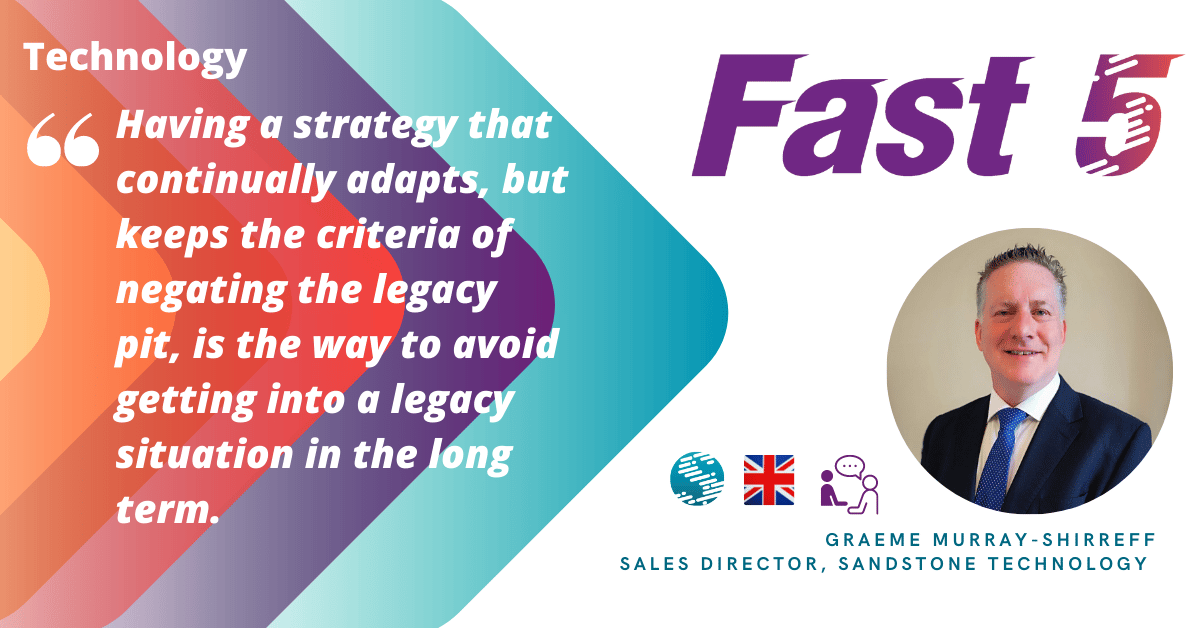Technology | Graeme Murray-Shirreff

At Sandstone Technology, Graeme is responsible for evangelising our digital solutions which are specifically designed for the financial services market. He works closely with new and existing clients to understand and explore (and address) their business challenges. We're catching up with Graeme on the topic of legacy platforms and their impact on financial services organisations which serve consumers.
We hear a lot about “legacy” platforms in the finance industry, usually from start-ups, vendors touting their latest technology stacks or from people with an agenda where the legacy fear-factor offers opportunities. I guess someone’s opinion about legacy platforms will be based on their own interpretation of what legacy means. So, when is the right time to use the word legacy ? We should attribute the word ‘legacy’ when:
• The systems or software in question starts to become problematic due to technologies it relies upon
• The skills required to develop and support are becoming limited
• Something is end-of-life and there is no natural upgrade path
• It can no longer be changed to meet the demands of the business/market/customers
• You can see significant benefits in adopting other technologies.
Just because you’re not on the latest version of a technology doesn’t mean you have a legacy platform. There are benefits of being on so called ‘legacy’ platforms: it’s proven at doing what it does. In addition, you have probably invested in skills, specific changes, organisational and business process alignment, all of which makes moving from this “legacy” platform more difficult and a big-ticket item.
I would say let’s forget about the word legacy, let’s understand how not to get ourselves into a position of what we have described above as legacy in the first place. To try and explain let me use the analogy of company car fleet. A company that ran a car fleet knew from experience that cars had a working life, after a certain mileage/age they became less reliable and would fail to fulfil their part in supporting the business processes. Experience said replace after 3 years, that way they knew that the car would not become a problem to the business. Now when using that same analogy within the IT sector, some sweat the assets for longer than they should. IIn summary, companies end up with legacy as they don’t have a long term strategy that supports on the ongoing replacement of the systems in a timely fashion, but adopt a once-and-done and worry about it in 3 to 10 years’ time.
Ok, so now we need to clarify what we mean by modern technology. To do this let’s forget the word “modern” too. Let’s imagine an organisation’s strategy contains certain criteria - it has to leverage the right technology (meaning it’s fit for purpose), ideally it needs to provide a business advantage against any peers (or an the very least not be a disadvantage), it has to know how to get to “what’s next” and it needs not to offer any challenges that would make it “legacy” for the duration of its tenure. So, the answer to the question, is not so much what are the benefits, but more how do we stop ourselves falling into the legacy pit, that way any benefits of a modern technology stack will be a bi-product of a non-legacy strategy.
In the context of what I have alluded to as legacy, I’m sure all financial services organisations would say they would love not to be in a position of having a legacy environment, but by this point companies have built up too much technical and knowledge debt. The question then posed is “how much will it cost to transition and what risks does that transition pose to the business?”. In my experience what doesn’t figure in that decision is what any new technology will deliver for the business, it’s all about the transition journey not the destination. It is only when the pain-points of legacy over-takes the risk factors that companies seriously consider a transition. Having a strategy that continually adapts, but keeps the criteria of negating the legacy pit, is the way to manage not getting into a legacy situation in the long term.
This question made me smile, it’s a little bit like the narrative above, when you ride a motorbike as a hobby it’s not about the destination, it’s about the journey. Whilst we talk about the places we’ve been (mainly western Europe), what usually comes up are the roads (or if not roads, the tracks when off roading), finding that road/track that’s a joy to navigate its twists and turns is what we look for. I think anyone who rides a bike (excludes anyone riding to commute😊) will understand where I’m coming from. In answering your question it’s made me realise…… my current road bike is falling into that legacy pit, so to maintain a consistent approach to work and life, I’m off to the bike shop!!!!
 Graeme began his career in electronic engineering building, calibrating, and testing various avionics devices. If you were lucky enough to take a trip on the Concorde, chances are Graeme had worked on the large LED screen displaying the aircraft’s speed in the cabin! If you were unlucky, you’d be in a RAF Tornado getting messages from the engine life recorder he’d calibrated! He has since moved through the ranks in varying technical and consulting roles for some of the largest global organisations including Unisys.
Graeme began his career in electronic engineering building, calibrating, and testing various avionics devices. If you were lucky enough to take a trip on the Concorde, chances are Graeme had worked on the large LED screen displaying the aircraft’s speed in the cabin! If you were unlucky, you’d be in a RAF Tornado getting messages from the engine life recorder he’d calibrated! He has since moved through the ranks in varying technical and consulting roles for some of the largest global organisations including Unisys.